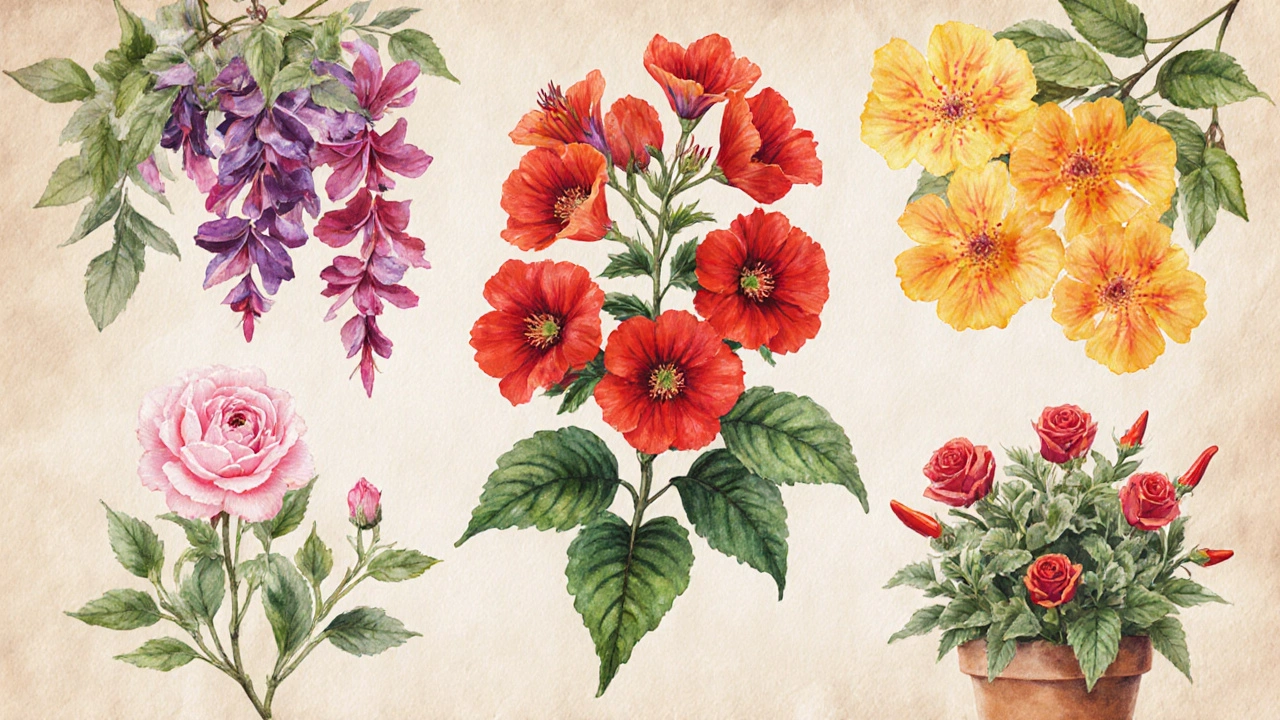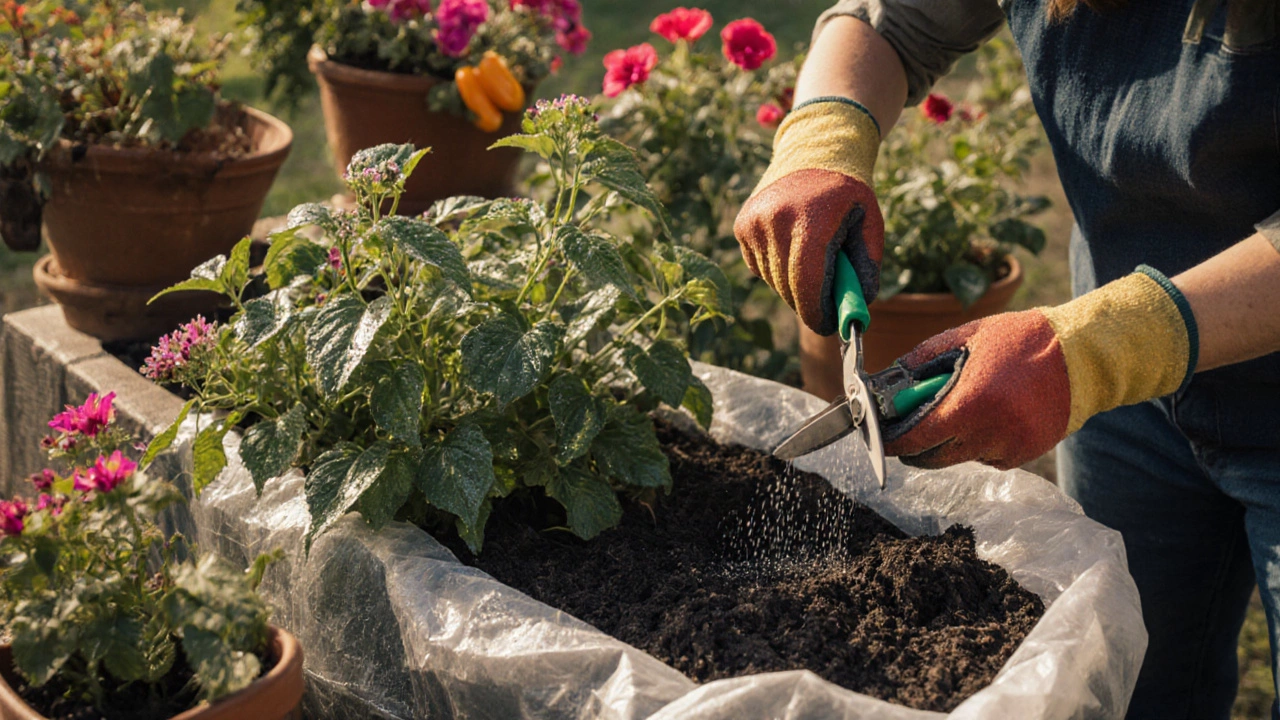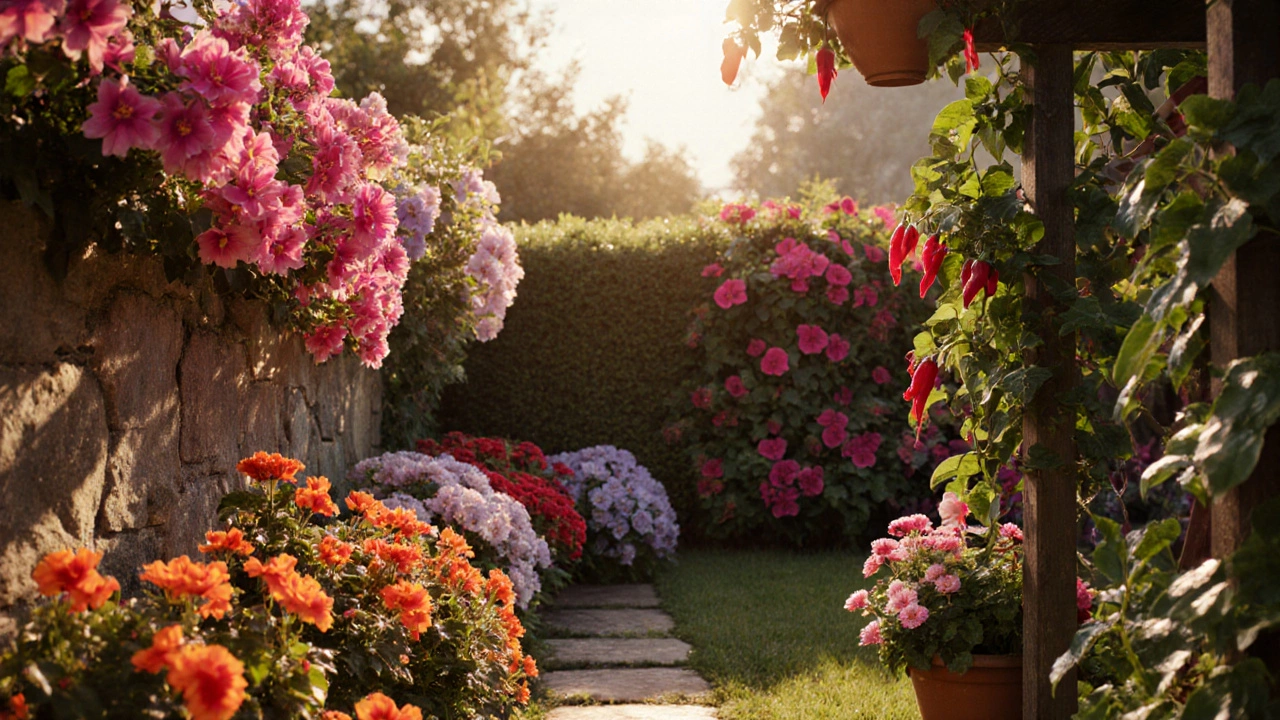Year-Round Bloomer Selector
Want a garden that never looks dull, no matter the month? It’s possible with the right selection of year-round blooming plants. By mixing species that thrive in sun, shade, and everything in between, you can keep colour flowing from January to December. Below you’ll find what to look for, which varieties deliver constant blossoms, and how to keep them happy all year.
Key Takeaways
- Choose a blend of sun‑loving and shade‑tolerant species to cover every season.
- Ever‑blooming roses, bougainvillea, and lantana are among the most reliable performers.
- Regular dead‑heading, proper fertilisation and moisture management are essential for continuous display.
- Pay attention to climate zones; most year‑round bloomers thrive in USDA zones 8‑11, but container tricks expand the range.
- Use the quick checklist at the end to audit your garden before planting.
Understanding What Makes a Plant Bloom All Year
When we talk about plants that bloom all year, we’re really talking about perennials that have the genetic ability to produce flowers repeatedly, given the right conditions. In horticultural terms, the key attributes are:
- Continuous growth habit: stems keep producing new shoots rather than dying back.
- Photoperiod flexibility: the plant is not strictly short‑day or long‑day, so it can flower when daylight length changes.
- Heat and moisture tolerance: the ability to survive summer droughts and winter chills.
Matching these traits to your local climate (Manchester sits in USDA zone 8b) helps narrow down the list.
Sun‑Loving All‑Season Bloomers
These plants love full sun (at least 6‑8 hours daily) and will keep producing vivid flowers when the temperature stays above 10°C.
Geranium is a classic bedding plant. It tolerates heat, rebounds from light frosts, and blooms repeatedly from late spring to frost. A single geranium can put out 30‑40 blooms per stem, making it a colour powerhouse.
Bougainvillea-often called paper flower-thrives in hot, dry spots. In Manchester’s milder summers, grow it in a large pot and bring it indoors for winter. Its bracts can last weeks, and new growth appears as soon as temperature climbs above 13°C.
Lantana produces clusters of tiny, brightly coloured flowers. It tolerates poor soil and tolerates both drought and brief freezes, so it can keep blooming from early summer through early winter in protected spots.
Hebe-a shrub native to New Zealand-offers tiny, insect‑attracting blossoms from early spring right through to late autumn. Its semi‑evergreen foliage adds structure when flowers are scarce.

Shade‑Friendly Year‑Round Bloomers
Gardens often have corners that never catch full sun. The following plants fill those gaps with colour.
Impatiens (particularly the ‘Double’ series) loves moist, shady spots and can flower virtually nonstop from spring until the first hard freeze. They prefer regular watering and a feed of balanced fertilizer every 4‑6 weeks.
Fuchsia is a pendant‑flower favorite for shade. While many varieties are short‑day, the ‘Graveyard’ hybrids have been bred for repeat blooming, producing cascades of mauve‑red blossoms well into late autumn.
Climbing hydrangea (Hydrangea anomala petiolaris) climbs walls and fences, shedding its blooms in late summer but re‑flowering on new growth if you prune back hard in early spring. Its glossy leaves stay green year‑round, adding visual interest even when flowers are sparse.
Ornamental peppers (Capsicum annuum) tolerate partial shade and deliver bright, pepper‑shaped blooms that turn into fruit. In a protected window box they can flower from early summer to winter, especially when dead‑heading stimulates fresh buds.
Ever‑Budding Rose Varieties
Modern shrub roses such as ‘Knock Out’ and ‘The Fairy’ have been bred for repeat blooming. They tolerate Manchester’s cooler winters when mulched, and they produce a steady stream of flowers from late spring to the first hard frost. A regular feed of rose‑specific fertilizer and weekly deep watering keep the vigor high.
Maintenance Tips for Continuous Blooms
Even the hardiest all‑season bloomers need a bit of care to stay productive.
- Dead‑head regularly: removing spent flowers forces the plant to set new buds.
- Balanced fertilisation: a 10‑10‑10 NPK applied every 6‑8 weeks fuels flower production without encouraging excessive foliage.
- Moisture management: most year‑round bloomers prefer consistent soil moisture. A mulch layer of 5‑7cm helps retain water and stabilises soil temperature.
- Pruning for shape: light shaping after each major flowering flush improves air flow and light penetration, reducing disease pressure.
- Winter protection: wrap tender stems in horticultural fleece or move container plants to a sunny indoor spot during the coldest months.

Quick Plant Comparison Table
| Plant | Light Requirement | Water Needs | Hardiness (UK Zones) | Best Use |
|---|---|---|---|---|
| Geranium | Full Sun | Medium | 7‑9 | Border edging |
| Bougainvillea | Full Sun | Low | 9‑11 (container) | Wall climber |
| Impatiens | Partial Shade | High | 8‑10 | Shade borders |
| Fuchsia | Partial Shade | Medium | 7‑9 | Hanging baskets |
| Climbing Hydrangea | Shade to Dappled Sun | Medium | 6‑9 | Wall/fence cover |
| Knock Out Rose | Full Sun | Medium | 7‑9 | Mixed shrub border |
Common Pitfalls and How to Avoid Them
Even enthusiastic gardeners can stumble. Here are the usual mistakes and quick fixes.
- Over‑watering: soggy soil rots roots, especially in container plantings. Use a moisture meter or stick your finger 2cm deep; water only when it feels dry.
- Under‑feeding: without regular nutrients, plants may produce foliage but few flowers. Set a calendar reminder for fertiliser applications.
- Choosing the wrong zone: some tropical bloomers, like bougainvillea, need winter protection. If you can’t bring them indoors, treat them as annuals in open beds.
- Ignoring pest pressure: aphids and spider mites love soft new growth. A gentle spray of water or neem oil every two weeks keeps numbers low.
Year‑Round Bloom Checklist
- Map out sunny vs. shady zones in your garden.
- Select at least three sun‑loving and three shade‑loving all‑season plants.
- Prepare soil with compost (25% of total volume) for moisture retention.
- Install drip irrigation or a soaker hose for consistent watering.
- Set a fertiliser schedule: every 6‑8 weeks during active growth.
- Plan a monthly dead‑heading routine.
- Arrange winter shelter for tender species.
Frequently Asked Questions
Can I grow year‑round bloomers in a small balcony?
Absolutely. Choose compact varieties like miniature geraniums, impatiens, or dwarf bougainvillea in containers. Use a lightweight potting mix, place pots where they get at least 4‑5 hours of sun, and set up a small drip system for steady moisture.
Do these plants need special pruning to keep blooming?
Light, regular pruning after each major flowering flush encourages fresh growth. For shrubs like roses or bougainvillea, trim back about one‑third of the older stems in early spring. For herbaceous plants, simply pinch back the tops to stimulate branching.
What soil pH works best for most year‑round bloomers?
A slightly acidic to neutral pH (6.0‑7.0) suits the majority of these plants. Test your garden soil with a simple kit and amend with lime to raise pH or sulphur to lower it if needed.
How do I protect tender plants like bougainvillea during Manchester winters?
Keep bougainvillea in a large, insulated pot, move it to a sunny indoor space (or greenhouse) when temperatures dip below 5°C, and reduce watering. A layer of horticultural fleece around the base adds extra warmth.
Is dead‑heading really necessary?
Yes. Removing faded blooms signals the plant to set new flower buds instead of diverting energy to seed production. This habit can add weeks of extra colour.

